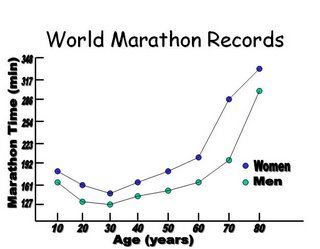Age and Intensity
I just got an email from someone on one of my favorite topics - aging and training. I've grown old thinking about this topic. Here's his question and my reply.
Q: I was having a conversation with a friend the other day about 45+ masters racing. We are both a decade or so away from 45+, so I'm not exactly sure why it became a topic of conversation. Like any good discussion/debate there were a series of point and counterpoints. I'll spare you the entire dialogue. Fundamentally, we were discussing the pros and cons to road racing in your 40s-50s. My unsubstantiated opinion is that aerobic exercise, including intensity just above or below LT, is probably good for overall strength and health; but I have my doubts about the benefits of anaerobic efforts for riders approaching their 50s. My unsubstantiated conclusion was that crits and road races probably do more harm than good, and middle aged or aged riders might get more benefit from steady state events.
A: Great topic. But I disagree strongly with you. I'm a big proponent of maintaining or even increasing the percentage of high intensity one does as he/she ages. Otherwise we begin to lose muscle mass. I see many older athletes who have done as you suggest and I've seen them wither over the years. The ones who raced and trained at high intensity stayed much more muscular and lean. At age 65 I do intervals and hill repeats several times a week.


